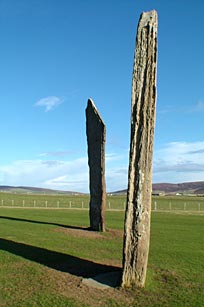
 |
 |
| Home |
| About Orkney |
| History |
| Tradition |
| Folklore |
| Placenames |
| Images |
| Downloads |
| About the Site |
| Contact |
| Links |
| Search Site |
| Awards |
| The Standing Stones of Stenness | |
"Even in daylight the place
has something uncanny about it. The Standing Stones of Stenness,
mouldering, scarred and grey with age, rising as they do from an
unbroken bed of heather always have a weird mysterious appearance."  Standing at a maximum height of six metres (around 19 feet), the sheer scale of the megaliths that make up the Stones o' Stenness, make the monument visible for miles around.
These are considerably larger than those found in the nearby Ring of Brodgar, approximately one mile to the north-west. The Standing Stones of Stenness were originally laid out in an ellipse. Although it is commonly written that the monument was once made up of 12 megaliths, excavations in the 1970s suggest that the ring was never "completed", with at least one - possibly two - of the 12 stones were never erected. Radiocarbon dates from the excavation show that the site dates from at least 3100BC, making the Standing Stones complex one of the earliest stone circles in Britain . Like the Ring of Brodgar, the Stenness ring has been classed as a henge monument. The stone circle was surrounded by a rock-cut ditch (four metres across and 2.3 metres deep). It was once believed that outside the ditch there was a substantial earth bank. This has been questioned in recent years — an absence of evidence suggesting that there was no exterior bank. With an approximate diameter of 44 metres (144 feet), the ditched enclosure had a single entrance causeway on the north side, facing the Neolithic Barnhouse settlement on the shore of the Harray loch. Little remains of ditch today, although traces remain visible around the stone circle. Today, at the centre of the ring, the visitor will see a large stone hearth, similar to those found in Skara Brae and other Neolithic settlements. The hearth was constructed from four large stone slabs, and, according to Dr Colin Richards, the excavator of the nearby Barnhouse Settlement, an earlier hearth was transplanted from Barnhouse to the centre of the stone ring. Close to the hearth stand two angular slabs, standing side by side, with a large prone stone beside them. This is the remains of the "dolmen" rebuilt in 1907 - although doubt remains that it was ever part of the original complex. Click here for more details. The Odin Stone and Watch Stone
Until the beginning of the 19th century, the complex contained at least one other significant monolith - the Odin Stone of Orkney legend. Temple of the Moon?
However, the origin and validity of this term is questionable. But temple or not, the ring was certainly involved in the later ceremonies and traditions surrounding the Odin Stone. One historical account tells that during the five days of New Year feasting, lovers would visit the Standing Stones where the woman knelt and prayed "to the god Wodden" that they might keep the oaths they were about to swear. They would then make their way to the Ring of Brodgar, where the kneeling "ritual" was repeated before finalising their pact before the Odin Stone . |
Although only four megaliths remain today, 18th century records show that, at the time, there were four stones standing, along with the stump of a fifth. A large stone slab also lay on the ground, not quite in the centre of the ring, and traces of the bank still surrounded the monument. The parish of Stenness owes its name to its towering megaliths. The name "Stenness" derives from the Old Norse "Steinn-nes", meaning "Stone Headland". The connection to the stones is clearly apparent in the correct Orcadian pronunciation of the parish name - "Stane-is". An 18th century map refers to the Standing Stones as the "Circle of Loda". This is the only recording of this name (possibly from the Old Norse hlað-á) and may refer to the causeway, or stepping stones, across the stream between the lochs of Harray and Stenness. |
 Located by the south-eastern shore of the Loch of Stenness, only four of the ring's stones remain.
Located by the south-eastern shore of the Loch of Stenness, only four of the ring's stones remain.  The layout of the Standing Stones of Stenness. The surviving stones are shown in black, with the sockets in grey. Doubt remains whether Stone 12 existed, and possibly Stone 9.
The layout of the Standing Stones of Stenness. The surviving stones are shown in black, with the sockets in grey. Doubt remains whether Stone 12 existed, and possibly Stone 9.  Other megaliths in the vicinity, now thought to have been part of the original complex, are the
Other megaliths in the vicinity, now thought to have been part of the original complex, are the 